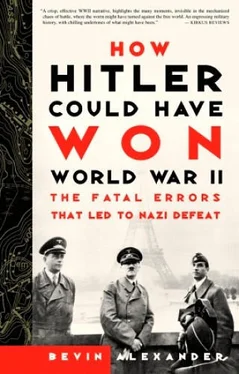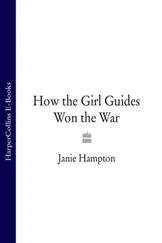The 22nd Brigade, caught isolated, was mauled in a concentric attack by both panzer divisions and also forced to withdraw. Africa Corps advanced to the Trigh Capuzzo and met the third British armored brigade, the 2nd, which attacked from the west but didn’t coordinate with the 1st Army Tank Brigade that charged recklessly from the east.
There was a period of panic when sixty Matildas and Grants smashed into the midst of the German forces, and overran a motorized infantry battalion. Nehring threw in his headquarters defense unit, a battery of 88s, a few tanks, and a company of light antiaircraft guns. Joined by sixteen additional 88s, the defenders formed a solid gun line, destroyed twelve enemy tanks, and forced the remainder to withdraw. The assaults cut off supply columns trying to bring up fuel and ammunition, and forced Africa Corps to close into a hedgehog perimeter for the night about three miles north of the Trigh Capuzzo.
The Axis forces had been forced to halt in a highly dangerous position with British forces blocking their movement north. Moreover, the only way the Germans and Italians could be supplied was by way of a wide detour around Bir Hacheim.
If the British had not wasted their strength in uncoordinated isolated fights by individual brigades, they might have converged on Rommel’s armor and ended the campaign in North Africa then and there. Rommel was especially astonished at the sacrifice of 7th Armored Brigade south of Bir el Harmat. “It was all the same to the British whether my armor was engaged there or on the Trigh Capuzzo,” he wrote. “The full motorization of their units would have enabled them to cross the battlefield at great speed to wherever danger threatened.”
Despite the failure on May 27, General Ritchie possessed another great opportunity to destroy Africa Corps on May 28 by a concentric attack, using the armor he already had in place, and bringing up the 32nd Tank Brigade, which had not been committed. But Ritchie took no such action, and Rommel had time to reorganize.
On May 28, Rommel intended for 90th Light to withdraw from the El Adem area and join Africa Corps for a concerted attack northward. But the division could not extricate itself from an attack by 4th Armored Brigade. As a result, Ariete Division and Africa Corps fought a confused series of engagements with British armor, which once more came in piecemeal. By the end of the day, Africa Corps had 150 tanks left fit for action, the Italians 90, while the British still had 420.
The 90th Light was able to withdraw during the night to Bir el Harmat, and early on May 29 Rommel himself led a supply column to replenish Axis forces with fuel and ammunition. On this day the British again launched one uncoordinated attack after another. The Germans were little affected and remained in a strong position.
But Rommel realized he could not continue northward until his supply line was secure, since trucks coming around south of Bir Hacheim were being attacked by British motorized forces.
He then made a bold decision that saved the campaign. While the rest of his forces went over to the defensive, Rommel ordered 90th Light to drive west while Italian infantry advanced east along the Trigh Capuzzo. In this way, he broke a supply line directly through the Gazala line minefields.
The 150th Brigade box at Got el Ualeb and the Free French box at Bir Hacheim were now isolated, and Rommel decided to destroy both. Their capture would eliminate all danger to the south and give him freedom of action.
Nevertheless, the plan posed enormous danger. Axis armor was still stymied deep in the British rear and could do nothing until an avenue of advance opened. Yet Ritchie had a clear path to victory. He could use his infantry and artillery to break a hole through the weak Italian divisions manning the Gazala line on the coast and drive west to sever the Axis supply line. Rommel had little to stop him. Such a move would leave Rommel’s panzers without fuel and endanger his whole position in Africa.
Rommel saw the peril clearly. But he had judged his opponents accurately. He knew the British generals would not think so much of opportunity as of danger. If they drove west along the northern coast road with part of their armor, they feared Rommel would rush north and cut their supply line. Yet the British had 400 tanks, plus AT guns, and—with the rest of their tanks—could have blocked Rommel’s remaining 130 German and 130 Italian tanks until their fuel ran out. Rommel was confident that the British would fix their attention on the Axis armor and “continue to run their heads against our well-organized defensive front and use up their strength.”
This is what happened. On May 30 British armor made sporadic, uncoordinated attacks broken up by German 88s and AT guns. By the end of the day, Axis forces had shattered fifty-seven tanks and established a firm front on the east-west Sidra Ridge, a mile north of the Trigh Capuzzo, and on Aslagh Ridge, about five miles south, enclosing an area the British named the Caldron.
Rommel thus had the time to assault the Allied boxes. On May 31 he personally led 90th Light, Trieste, and elements of Africa Corps against the 150th Brigade box. Aided by a regiment of Matildas, the British resisted stubbornly, but their situation was hopeless, and the next day, after a heavy attack by Stuka dive-bombers, out of ammunition and water, they gave up 3,000 men.
On June 2, 90th Light and Trieste assaulted the Bir Hacheim box. The fight turned into one of the fiercest in the war, lasting ten days. The French and Jewish defenders fought skillfully from field positions, machine-gun and AT nests, and slit trenches. They endured intense dive-bombing: 1,300 Stuka sorties in nine days. The Luftwaffe suffered, for RAF fighters shot down forty Stukas on a single day.
On June 5, the British tried once more to destroy Axis armor in the Caldron, but they still made direct, obvious, piecemeal attacks.
To the north, slow, heavy Matilda and Valentine infantry tanks lumbered forward in daylight, unsupported by artillery fire, and provided perfect targets for AT guns of 21st Panzer on Sidra Ridge. The British armor ended in a minefield and were shot to pieces, losing fifty of seventy tanks engaged.
To the southeast the 10th Indian Brigade drove Ariete Division off Aslagh Ridge. The 22nd Armored Brigade then passed into the Caldron, followed by the 9th Infantry Brigade. The British tanks received tremendous fire from German AT guns and artillery, and withdrew to Bir el Tamar, between Aslagh and Sidra Ridges. At midday, Rommel launched one of his most brilliant counterstrokes. While 21st Panzer thrust southeast toward Bir el Tamar, 15th Panzer emerged from a gap in the minefields south of Aslagh Ridge and struck the flank and rear of the Indian troops holding the ridge. By nightfall the Axis had shattered 9th Infantry Brigade and formed a ring around 10th Indian Brigade on Aslagh, as well as the armored division’s Support Group and four field artillery regiments to the north.
Rommel predicted that the British generals would draw no forces from the Gazala line or from the Tobruk garrison to exert pressure against the Germans ringing the British in the Caldron. They did not, though this was the only way to rescue the trapped soldiers.
“In a moment so decisive, they should have thrown in all the strength they could muster,” Rommel wrote. “What is the use of having overall superiority if one allows one’s formations to be smashed piece by piece by an enemy who, in each separate action, is able to concentrate superior strength at the decisive point?”
By the end of the day on June 6, Africa Corps had destroyed a hundred tanks, wiped out 10th Brigade, and captured 3,100 men, ninety-six cannons, and thirty-seven antitank guns. Total British tank strength had fallen to 170.
Читать дальше


![Джонатан Димблби - Barbarossa - How Hitler Lost the War [calibre]](/books/385421/dzhonatan-dimblbi-barbarossa-how-hitler-lost-the-w-thumb.webp)









